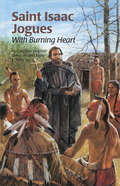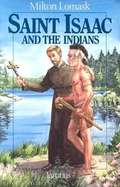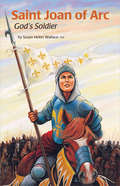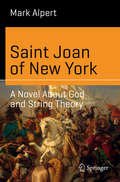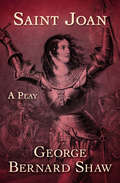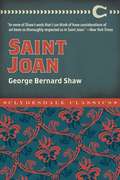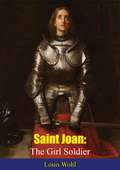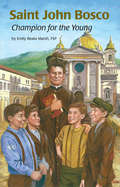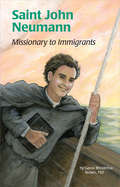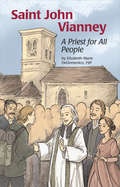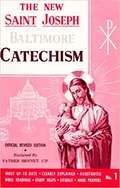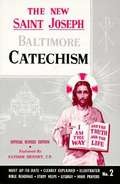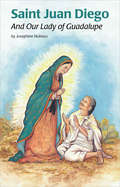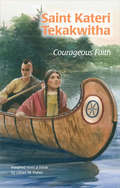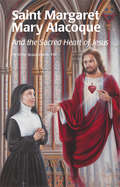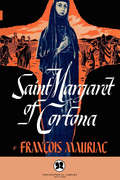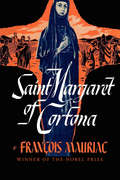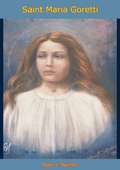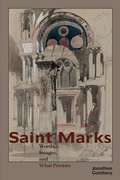- Table View
- List View
Saint Isaac Jogues
by Christine Virginia OrfeoNo difficulty could stop this heroic Jesuit priest. Father Isaac's greatest desire was to bring Jesus to the Native Americans he encountered in the wilderness of the New World.
Saint Isaac and the Indians
by Milton LomaskOver three hundred years ago, many Frenchmen came to the unknown forests along the St. Lawrence River. Most of them came in search of furs and wealth. But there were some--a handful of Jesuit missionaries--who came not to get, but to give. They wished to give the savage Indians the knowledge of God and of His love for them. One of these missionaries was Isaac Jogues, martyr and Saint. This is the story of his dangerous and difficult life among the Indian tribes in their tree-dark country--of his work of conversion, of his efforts to teach the Indians rules of health and to set them free from their superstitious belief in the power of their medicine men. This is the inspiring story of his enslavement by the Mohawks, his daring escape, and finally, his death as a martyr for the Faith.
Saint Jean-Marie Vianney
by Margaret TrouncerJean-Marie Vianney, known as the Cure of Ars, was not a brilliant scholar, but rather a humble priest who drew masses of people to God through his compassion, kindness, and humility.
Saint Joan of Arc
by Susan Helen WallacemMany have been introduced to the story of Saint Joan of Arc through big screen movies and TV. This biography follows her life, illustrating how she heard God's call to fight for her country.
Saint Joan of New York: A Novel About God and String Theory (Science and Fiction)
by Mark AlpertSAINT JOAN OF NEW YORK is a novel about a math prodigy who becomes obsessed with discovering the Theory of Everything. Joan Cooper, a 17-year-old genius traumatized by the death of her older sister, tries to rebuild her shattered world by studying string theory and the efforts to unify the laws of physics. But as she tackles the complex equations, she falls prey to disturbing visions of a divine being who wants to help her unveil the universe’s mathematical design. Joan must enter the battle between science and religion, fighting for her sanity and a new understanding of the cosmos.
Saint Joan: A Play (Penguin Classics Ser.)
by George Bernard ShawThe great Irish playwright&’s impassioned dramatization of the life and trial of Joan of Arc. Three years after Joan of Arc was canonized in 1920, George Bernard Shaw brought to the stage a more complex and human portrayal of the fifteenth-century French martyr, creating one of the theater&’s most memorable and enduring female roles. Already renowned for plays such as Pygmalion, The Arms and the Man, and Major Barbara, Shaw presented Saint Joan as &“A Chronicle Play in Six Scenes and an Epilogue.&” The play begins in February 1429 as a visionary peasant girl feels called to lead a French army against the English in the Hundred Years War in order to install Charles VII, the dauphin, to the throne. Rallying the troops, Joan plays a pivotal role in the siege of Orléans and in the crowning of Charles at Reims Cathedral. The play culminates with Joan&’s trial for heresy after she is captured by opposing forces and ultimately condemned and burned at the stake. Through the device of an epilogue, Shaw dramatizes the reevaluation of Joan through a retrial a quarter century after her execution that clears her of heresy to declarations of her as a Christian martyr and ultimately almost five centuries after her death, her canonization as a saint. Shaw&’s Joan is an upstart and a rebel—sane, self-assured, proud, courageous, but still with the naivete of the teenager she was—who challenged the conventions of her time as well as those in power. Having exhaustively researched the documents of her trial, Shaw added a preface and series of reflections on Joan to the published text of the play, which offer further insight into a legendary figure who continues to fascinate, intrigue, and provoke a myriad of interpretations, as well as ongoing productions of Shaw&’s only tragedy. This ebook has been professionally proofread to ensure accuracy and readability on all devices.
Saint Joan: Her History And The Play (Clydesdale Classics)
by George Bernard ShawRediscover the story of the inspirational Saint Joan of Arc with the classic play by George Bernard Shaw. The historical saint begins her story as a simple country girl in fifteenth century France who is inspired by visions from God to help liberate her country from the English. She secures soldier&’s clothing and convinces the soon-to-be king, Charles, to begin battling for his country. Though her regiment succeeds in battle after battle, her enemies (the English) move against her. When Joan moves to liberate Paris from the English control—against the advice of her friends—she is captured and tried for heresy. Despite help from a Bishop and the Inquisitor, who truly want to see Joan succeed, her beliefs simply do not match with the Church; people do not hear visions from God, only from the church, therefore Joan must be possessed by demons. Subsequently, Joan is sentenced to death. Now read this beautiful new edition of the talented George Bernard Shaw&’s play, Saint Joan. Discover why the Catholic Church made this young woman into one of the most famous saints known today.
Saint Joan: The Girl Soldier
by Louis De WohlThis book combines a world-famous Catholic novelist, Louis de Wohl, with one of the most thrilling and dramatic saints' lives in history, St. Joan of Arc. De Wohl uses his famed narrative skill to tell young people about the brave teenage French girl who had visions and led armies in battle, but also about how her entire life testifies to the amazing power of God's grace.It's all here: how Joan, a humble maiden in an insignificant town, was told by St. Michael the Archangel, St. Catherine, and St. Margaret to lead the French in battle against the English; how she finally succeeded in convincing the French of the truth of her mission; how she met with fantastic success but was betrayed, captured, and imprisoned; and finally, how she suffered through a politically motivated trial for heresy and was burned at the stake.De Wohl is interested not solely in the external details of Joan's life, but in Joan's all-encompassing love for God, which informed all her courageous actions from beginning to end. You'll not only thrill to Joan's heroism; your heart will delight in her example of loving surrender to God's will. Every detail of her life will ring out to you as a joyful witness to the grace of God.
Saint John Bosco: Champion for the Young
by Wayne Alfano Emily Beata Marsh FSPIntroduce readers ages 9-12 to a saint known worldwide for his work with youth and who understood how to help children both love God and have fun, using their youthful energy for good.
Saint John Neumann
by Virginia Esquinaldo Laura Rhoderica Brown FSPLearn about the life of the holy man who became the only canonized North American bishop, St. John Neumann. Join him on his adventures in following God’s will as he travels from Europe to America and becomes a Redemptorist priest. Later, when the pope makes him bishop of Philadelphia, he journeys throughout his new diocese to meet the people. Listening to the needs of his flock, he built thirty churches, started the Catholic school system, and was loved by all.
Saint John Paul The Great: His Five Loves
by Jason EvertThe book unfolds the five great loves of St. John Paul II through remarkable unpublished stories on him from bishops, priests, students, Swiss Guards, and others. Evert explores in depth his five great loves: Young People, Human Love, The Eucharist, Our Lady, The Cross. By looking at what he loved and why, the goal is to help readers learn more about key aspects John Paul's life and teachings, including Theology of the Body, Divine Mercy, Total Consecration, Eucharistic adoration, and redemptive suffering.
Saint John Vianney
by Elizabeth Marie DedomenicDiscover the life story of St. John Vianney--beloved patron saint of parish priests. From his youth during the tumultuous French Revolution, to his difficult years of study and amazing work to rebuild the parish of Ars, John Vianney is a model of love for God that spilled over into tireless care for others. Historical and cultural details make the story of this remarkable saint come alive for young readers.
Saint John's Abbey Church: Marcel Breuer and the Creation of a Modern Sacred Space
by Victoria M. YoungIn the 1950s the brethren at the Benedictine Abbey of Saint John the Baptist in Collegeville, Minnesota—the largest Benedictine abbey in the world—decided to expand their campus, including building a new church. From a who&’s who of architectural stars—such as Walter Gropius, Richard Neutra, Pietro Belluschi, Barry Byrne, and Eero Saarinen—the Benedictines chose a former member of the Bauhaus, Marcel Breuer. In collaboration with the monks, this untested religious designer produced a work of modern sculptural concrete architecture that reenvisioned what a church could be and set a worldwide standard for midcentury religious design. Saint John&’s Abbey Church documents the dialogue of the design process, as Breuer instructed the monks about architecture and they in turn guided him and his associates in the construction of a sacred space in the crucial years of liturgical reform. A reading of letters, drawings, and other archival materials shows how these conversations gave shape to design elements from the church&’s floor plan to the liturgical furnishings, art, and incomparable stained glass installed within it. The book offers a rare detailed view of how a patron and architect work together in a successful building campaign—one that, in this case, lasted for two decades and resulted in designs for twelve buildings, ten of which were completed.The post–World War II years were critical in the development of religious and architectural experiences in the United States—experiences that came together in the construction of Saint John&’s Abbey and University Church and that find their full expression in Victoria M. Young&’s account of the process. Using the liturgy of the mid-twentieth century as a cornerstone for understanding the architecture produced to support it, her book showcases the importance of modernism in the design of sacred space, and of Marcel Breuer&’s role in setting the standard.
Saint Joseph Baltimore Catechism (Official Revised Edition No. #1)
by Bennet KelleyThe New St. Joseph Baltimore Catechism No. 1 from Catholic Book Publishing contains the revised text of the Official Baltimore Catechism No. 1 in a user-friendly format and design. Baltimore Catechism explains Catholic doctrine with the aid of many exclusive features, including a large number of pictures to help children understand each lesson. Extensive use of Sacred Scripture demonstrates the basis of Catholic doctrine and brings it to life. This book combines a contemporary viewpoint and language with a solid time-tested exposition of Catholic Church teachings.
Saint Joseph Baltimore Catechism (Official Revised Edition No. #2)
by Bennet KelleyThis Catechism aims at combining the old with the new. Of the old, it retains the text of the Revised Baltimore Catechism, Number two. This is still the standard text for the middle and upper grades of grammar school in most dioceses.
Saint Joseph Edition of the New American Bible (Revised Edition)
by Confraternity of Christian DoctrineThe New American Bible Revised Edition (NABRE) brings to culmination the work of nearly 100 scholars, including translators, editors, and a subcommittee of Catholic bishops who provided extensive review of the biblical text over a period of many years. The NABRE is the first major amendment to the New American Bible translation since 1991. It features: <P><P> * The first update of the Old Testament since 1970, taking into account recent archaeological and textual discoveries.<P> *Complete revision of the Psalter.
Saint Juan Diego
by Josephine Nobisso Virginia EsquinaldoLearn the fascinating story behind Mary's apparition to a humble Aztec farmer in Mexico. Discover why this "miracle of the Americas" continues to touch so many people throughout the centuries.
Saint Kateri Tekakwitha
by Barbara Kiwak Lillian M. FisherUncover the "sunshine" of a Mohawk-Algonquin girl who experiences loss, ostracism, and religious persecution, yet courageously holds on to her faith. Perfect for ages 9-12, this 31st volume in the Encounter the Saints series familiarizes children with the first Native American woman to be declared a saint. Her life story is set within colonialism that brought undesirable consequences and tribal tensions that intensified with the arrival of Christian missionaries. The Encounter the Saints series offers intermediate readers relatable portrayals of the saints. Each story, in a handy format, vividly recreates the saint's place of origin, family life, and corresponding historical events.
Saint Katharine Drexel, Apostle to the Oppressed
by Lou BaldwinFrom the book: When the Catholic Church, through the intricate canonization process, declares an individual a saint, it gives recognition to the heroic virtue of his or her life, and says, "Beyond a doubt, this wonderful person has achieved what should be the goal of everyone - salvation." While canonization bestows a certain amount of honor and glory on the newly named saint, the real purpose is to present that holy man or woman as a worthy example for those of us still on earth. Katharine Drexel cannot be dismissed as a social worker in religious garb. Nor is she merely the foundress of a religious congregation for women. Her "heroic virtue" shines through on several levels. First of all, there is her own formation in an extraordinarily pious family, which looked beyond wealth to man's duty to man. There is also her own complete renunciation of money and the things it buys for service to others. There is her great love of God, best exemplified by her devotion to the Eucharistic Christ. There is her deep empathy with people of color, flying in the face of the prevailing prejudices of her day. And ultimately, there is her determination to help these same persecuted people know Jesus Christ, a commission accepted by all too few of her own co-religionists. Katharine Drexel became a saint, not by flat of the Pope, but by showing others a road to sanctity. Her path might be different than that of a St. Isaac Jogues, a St. Paul or a Dorothy Day - ultimately we choose our own path. But her example is one of the shining guideposts that can guide us as we journey in this new millennium.
Saint Margaret Mary Alacoque: And the Sacred Heart of Jesus
by Emily Beata Marsh FSPMargaret Mary Alacoque knew in her heart that she wanted to serve Jesus, but little did she know that Jesus had a special message for her about his Sacred Heart! Through her efforts, everyone would know about Jesus’ twelve promises to those who love his Sacred Heart. This 37th volume in the Encounter the Saints series familiarizes children ages 8 to 10 with Saint Margaret Mary Alacoque, who helped spread devotion to the Sacred Heart of Jesus throughout the world!
Saint Margaret of Cartona
by François MauriacMargaret of Cortona was an Italian penitent of the Third Order of St. Francis. She was born in Laviano, near Perugia, and died in Cortona. She was canonized in 1728. She is the patron saint of the falsely accused; hobos; homeless; insane; orphaned; mentally ill; midwives; penitents; single mothers; reformed prostitutes; third children; tramps. Saint Margaret of Cortona aroused Mauriac's interest because very little was known about her in France and because she succumbed to human love and even had a child. This interest distracted him in a time when the Germans were all over France and he followed her wherever she led him. This is the story of one such spiritual encounter.
Saint Margaret of Cortona
by François MauriacThe Nobel Prize–winning author&’s stirring biography of the thirteenth-century Italian penitent who become the patron saint of the homeless. Born in 1247 to a farming family in a small village outside Perugia, Margaret of Cortona was willful and reckless in her youth. At age seventeen, she became a wealthy man&’s mistress—even bearing his son out of wedlock. But her life of sin ended when she found her lover murdered. Devoting herself to prayer and penance, Margaret eventually joined the Third Order of St. Francis and took a vow of poverty. She established a hospital for the poor and homeless at Cortona. On divine command, she challenged her own bishop for his lavish and warlike lifestyle. Canonized by Pope Benedict XIII in 1728, she became a patron saint of the downtrodden, including the falsely accused, homeless, orphaned, and mentally ill, as well as midwives, penitents, single mothers, reformed prostitutes, and third children. For François Mauriac, Saint Margaret of Cortona became a source of fascination and solace during the Nazi occupation of France. During that time, feeling himself and all his countrymen to be among the downtrodden, he wrote this biography.
Saint Margaret, Queen Of The Scots
by Catherine KeeneMargaret, saint and 11th-century Queen of the Scots, remains an often-cited yet little-understood historical figure. Keene's analysis of sources in terms of both time and place - including her Life of Saint Margaret , translated for the first time - allows for an informed understanding of the forces that shaped this captivating woman.
Saint Maria Goretti
by Marie C. BuehrleSt. Maria Goretti became a martyr at the young age of 12 years old. Her heroic resistance to a familiar evil and the ultimate conversion of her assassin is an inspiration for all. 15 Illustrations throughout the book. She is compared to the brave St. Agnes who also gave her life to avoid sin. Patron saint of youth, young women, purity, and victims of rape. A powerful story of forgiveness.—Print ed.
Saint Marks: Words, Images, and What Persists
by Jonathan GoldbergSaint Marks invokes and pluralizes the figure of Mark in order to explore relations between painting and writing. Emphasizing that the saint is not a singular biographical individual in the various biblical and hagiographic texts that involve someone so named, the book takes as its ultimate concern the kinds of material life that outlive the human subject.From the incommensurate, anachronic instances in which Saint Mark can be located—among them, as Evangelist or as patron saint of Venice—the book traces Mark’s afterlives within art, sacred texts, and literature in conversation with such art historians and philosophers as Aby Warburg, Giorgio Agamben, Georges Didi-Huberman, T. J. Clark, Adrian Stokes, and Jean-Luc Nancy. Goldberg begins in sixteenth-century Venice, with a series of paintings by Gentile and Giovanni Bellini, Tintoretto, and others, that have virtually nothing to do with biblical texts. He turns then to the legacy of John Ruskin’s Stones of Venice and through it to questions about what painting does as painting. A final chapter turns to ancient texts, considering the Gospel of St. Mark together with its double, the so-called Secret Gospel that has occasioned controversy for its homoerotic implications.The posthumous persistence of a life is what the gospel named Mark calls the Kingdom of God. Saints have posthumous lives; but so too do paintings and texts. This major interdisciplinary study by one of our most astute cultural critics extends what might have been a purely theological subject to embrace questions central to cultural practice from the ancient world to the present.
